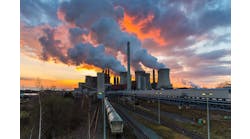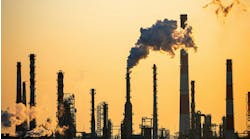Podcast: Lessons Learned From The Seveso Environmental Disaster
Was the Seveso accident, which released dioxin in the air and was named by Time magazine as one of the top manmade environmental disasters, a black swan event? Not likely, according to Trish Kerin, director of the IChemE Safety Centre. On the 45th anniversary of this catastrophic event, we take a look at lessons learned.
Transcript
Traci: Welcome to this edition of "Process Safety with Trish & Traci," the podcast that aims to share insights from past incidents to help avoid future events. I'm Traci Purdum, executive digital editor with Chemical Processing. And, as always, I'm joined by Trish Kerin, the director of the IChemE Safety Centre. Hey, Trish, how are you?
Trish: I'm doing well, Traci. How are you doing?
Traci: I'm doing all right. Not too bad. Looking forward to our conversation. Today, we have an anniversary coming up on one of our incidents, and these podcasts always do well for us. People love to learn from past incidents. So today we're talking about the Seveso incident and industrial accident that occurred on July 10th, 1976 in a small chemical manufacturing plant just north of Milan in Italy. It resulted in the highest known exposure of dioxin in residential populations. This accident was ranked eighth in a list of the worst manmade environmental disasters by "Time" magazine in 2010. Can you give us a brief rundown of what happened that led to this disaster? I know there's a lot involved. So I'm anxious to hear how you can break this down for us a little bit better.
Trish: I'm going to try. This is a very complex series of chemical reactions that took place, and I need to give a little bit of background so we can make a little bit more sense out of it. So I hope I get it perfectly correct because it is quite complex. And there's some really hard words to say here, Traci, I have to say. So, basically, there's a facility that was trying to make 2,4,5-sodium trichlorophenolate and sodium chloride after the first stage. And that then gets acidulated with hydrochloric acid to produce the final product. Now, in that process, there is a side reaction that occurs that produces a substance called 2,3,7,8-tetrachlorodioxin, and so that is a dioxin. So we know that dioxins have an impact on humans, animals, and the environment alike, quite a substantial impact. So the idea is you want to avoid making that substance, which I'll now call TCDD because it's a lot easier to say. We've got to try and avoid the TCDD manufacture. So there was a process that was being undertaken where they were using exothermic reactions to achieve these various different reactions. So there were several stages of reaction to go through to get to the final product. And they basically had a steam coil heating system in about a 10,000-liter reaction batch reactor that they were using. And they could circulate some cooling water in there as well to maintain temperature at the appropriate levels.
And they were using ethylene glycol as a solvent in addition to the xylene to try and remove the water as they went through the process. The ingredients are then typically heated to about 150 degrees C until there's no further water forming. So, obviously, we're boiling the water off. The temperature is then slowly increased to about 170 degrees C to remove the xylene. And the ethylene glycol is then currently extracted under vacuum. So we've got a few different processes that happen and a few different things that occur as we go through it. Now, the safety philosophy that followed at this site was that the operator had to carefully monitor the temperature because the goal is to prevent the formation of TCDD because we don't want that. The main protection on the reactor was a bursting disk which was set at 3.8 bar. And that was designed to protect for the initial stages of the reaction so that it wouldn't lose...you had a catastrophic loss of containment. So that was basically the process. Now, when it came to the day of the incident, what actually happened was the reaction was stopped was shut down with only 15% of the solvent removed. Now, it hadn't been fully removed. And that was counter to the operating procedures. The operating procedures stipulated that either no solvent should be removed or that all solvent should be removed. It shouldn't be stopped in the meantime. But it was stopped, and the reason it was stopped is that it was actually stopped at the end of a shift, shift time, because the facility wasn't allowed to operate over the weekend. So the reaction was stopped at 6 a.m. on the Saturday morning so that they could go home because they weren't allowed to work on the weekend. Now, when they shut it down, that meant that they were no longer stirring the reactor or agitating it, they were no longer heating or cooling the reactor, so the reactor was just left to sit there. It was at a temperature of about 158 degrees C, we think, at that time.
No worries! Subscribe and listen whenever, wherever.
Now, about six and a half hours later, the bursting disk bursted, and there was a release, and there was an aerosol release from the reactor. And it contaminated about 1800 hectares of area. It covered four municipalities. And it created a substantial amount of damage. Now, there are some various different reasons. And it was... Essentially, we believe that it was because there was...a runaway reaction continued to occur after the equipment had been shut down. Even though it wasn't near the temperature that should have created the reaction to get the TCDD, it seems as though there were actually thermoclines within the reactor, and where the temperature was being taken, it was less than the temperature that reacts to cause TCDD. But in the pocket of the reactor, it seems as though it had exceeded its temperature where it would be formed and therefore initiate an exotherm at that point in time. So a very complex process in terms of creating the conditions to form this dioxin that was then formed.
As I said, it spread over a substantial area. A very small amount left the facility, but it was spread over such a large area. And the fact was that you don't need a lot of dioxin to cause a problem, resulted in a substantial incident occurring. Now, fortunately, no humans died in this incident. But the environmental toll of this incident was substantial. And there was an enormous number of animals, farm animals, that needed to be slaughtered as a result because they were contaminated and sick. And so that was quite a substantial agricultural impact as well as the farming land was contaminated at that point. A lot of people suffered chloracne as a result of the dioxin exposure. And a lot presented to the hospital to be treated at that point in time. But, as I said, fortunately, there were no humans that were actually killed in that incident.
Traci: Now, reading up on this and trying to understand it, under my impression, it seems like plant management didn't think that something like this could happen. And they were talking about the foreseeability. And it wasn't foreseeable. Can you comment on the checklist that happens with foreseeability and how that's evolved since this incident?
Trish: Yeah, so this is an interesting one. It's an old argument that, well, we didn't think that could happen. But, actually, in this management and in process safety, you have to apply some form of thorough process to explore the different options that could happen. Now, they knew that they could get the formation of TCDD. And they had procedures there to deal with that. They knew that that could occur. They knew that they needed to stop the reaction either with all the solvent in situ or none of the solvent in situ, not halfway through the process.
But they were then using quite simple processes to do the temperature control on quite a substantial exothermic reaction risk. So the issue that they've got there is some of it, they did foresee, but they didn't then connect that that could continue effectively in a reaction chain, which is what we're seeing, well, when this happens, the next thing is going to happen, and the next thing is going to happen. And we're going to end up with an incident where we have actually released to the atmosphere. And so that's where we now have a series of different checklists and different processes. We have formalized hazard identification processes that we now use to identify the different hazards that are present and look at what the consequences could be from those hazards. And then we go through and do our PHAs at that point in a lot of detail to determine and understand what is foreseeable for us.
The challenge of foreseeability can be very difficult. In hindsight, it's crystal clear. We don't have hindsight at the start of an incident before it occurs, so that's the challenge we have. So we need to be able to figure out ways to help ourselves see some of these things a little bit clearer, to start with. And that's through that structured assessment process that we have to have.
You might have heard the term black swan event. A black swan event is typically used to describe an event that was unforeseeable. However, the use of the term black swan has actually been misused over the years and has now started to be applied to chemical processing type incidents. I don't believe you can have a black swan in a chemical type processing incident because it's all about the unforeseeability of something by the people that were in control and had the knowledge. Now, if you don't have the knowledge of what the hazards are in your facility, then you probably shouldn't be in control of that facility. Let's face it. So it's only a true black swan if the people in control had no hope of having any foreseeability on it. And I certainly don't think that this was the case with Seveso, and I don't think it's the case going forward with other incidents as well. It's just been a convenient way to try and say, "Well, that was really bad, and we didn't expect that to happen, so we'll call it a black swan." That's not what a black swan was about.
Traci: Now, is this ignorance, why it took so long for the company to admit to the public that dioxin was released into the air? As you said, a lot of damage was done in that 10 days. And with the environment, the ground, the animals, and the people. No one died, but that chloracne just looked horrific. If you could travel back 45 years, what would you advise to happen? And was it truly an ignorance where they didn't even realize what was going out into the environment there?
Trish: Yeah, look, I think they were trying to figure out what was going on. And I don't think they actually deliberately made decisions that they knew were going to harm the community. And no matter at what time they told the community, there was certain damage that could not have been avoided at that point. So what could not have been avoided really was the contamination of the land and possibly the contamination and impacts to a lot of the livestock. What they could have done, though, if they had have communicated it earlier, and they could have ordered local shelter in place, they could have avoided the fallout on the people. And if there had even been enough warning and enough communication, they may have been able to have rescued some of the wildlife before this actually occurred because it did take time to spread. And it also probably happened at one of the worst times. It was middle of the day, on a nice weekend. People were out and about doing things. They were out being contaminated with this product at the time.
So my best advice is the moment you are aware there is any chance of something going on that could impact outside of your boundary, you need to be sharing that with the authorities, and you need to be working with your local authorities on what shelter in place, or indeed if it does need to go to evacuation is needed as soon as possible to minimize the damage that could be costly. If people had have sheltered in place, we would not have seen the levels of impact to them that we saw. If they'd have had a better chance, these were some small little farms with small little barns, they potentially could have got some of their animals inside, and then not all of their animals were killed in it. There could have been ways to have mitigated some of these. But that doesn't mean that you do need to admit that something went wrong. You need to be upfront and honest about it. We saw a similar issue happen with Chernobyl. So a lot of it was played down that, "No, there's nothing to see here, nothing going on, nothing going on. No, the reactor hasn't melted down. That's not possible," whilst contamination was being sprayed over the area. And people were coming out to watch the pretty colors in the sky, as opposed to getting away from the radioactivity because they didn't know that's what they were looking at. So that community communication is just so important, making sure your communities around your facilities know what action to take in the event of an incident. How have you communicated to them what their role is going to be in an incident so that they can take that action and look after themselves and not leave a more significant impact?
Traci: Definitely be safer. It's better to be safer than sorry. You can go back and say, okay, there was nothing that we needed to worry about in this incident. But this we want to make sure that our environment and our community is safe. And those farms, I mean, they were decimated. Those small-time farms were decimated for years, right? They couldn't grow anything in that environment for a good long time. I don't even know if they can now. I think there's a park there now, right?
Trish: Yeah, I think so. Yeah.
Traci: What about the investigation after the incident? What was learned from those missteps?
Trish: Well, it was quite... Again, this incident, whilst it's so prominent in some parts of the world, it actually is still shrouded in mystery. The investigation itself was a government one that was instituted, but it didn't seem to have been instituted by or given to people that were necessarily competent to investigate such a complex chemical reaction and incident. Because there were a lot of questions that remained unanswered in the investigation that if you were a chemical engineer looking at it and saying, "Well, I'm going to do this investigation. These are some of the fundamental questions I should be asking," and those questions were not asked. So there wasn't a lot of information that came out about the investigation either. And so more of it has come out over the years. When it was originally published, it was published in Italian, and that needed to be translated to English so others could read it. But the investigation probably wasn't as thorough as it could or should have been, I would suggest, for such a significant incident. But, fortunately, it didn't stop there. Whilst it was acknowledged that perhaps the investigation could have been better, the European Union at the time looked at it and said, "This can never happen again. We need to do something about it." And so they ended up developing what was called the Seveso Directive, and it was one of the many European Union directives to get developed. And a directive means that every member country of the European Union must implement it. So it's not just a guideline, it's a directive. Your country, you must implement this law. And that's one of the things that's quite unique about the European Union. There are some common laws that exist across the continent there or the European Union itself.
And so the Seveso Directive was implemented. And the Seveso Directive is the forerunner of what we now call in some jurisdictions the Safety Case. So the Safety Case legislation that we see in a lot of countries around the world, and we don't see it in the Americas, but it is now prevalent, obviously, throughout Europe into parts of Asia, Australia, New Zealand, have all adopted a Safety Case regime for the management of their major hazards. And it all goes back to the Seveso incident, which is why, as I said, it's a word that is...if you're in jurisdictions that have Safety Case, the word Seveso is very well-known. If you're in a jurisdiction that doesn't have a Safety Case, it's probably a less-known incident. Yet it is one of the major world-changing incidents because of the legislative regime that it brought in. And then the Seveso Directive was updated to what got to Seveso II. And more recently, it was updated to Seveso III Directive. So each time a new directive, a new edition is released, all the European Union countries have to go and update all the changes. If you're not in the European Union, you don't have to update the changes, though. So, for example, Australia, New Zealand are operating under Seveso II effectively whereas Europe, including the UK, because Seveso III was put out before Brexit, is operating under Seveso III Directive rules. So it introduced the idea that you actually have to identify all the hazards that could lead to a major incident. You then have to implement controls to prevent those incidents occurring. You have to have measures on those controls. You have to have measures in place to understand the impact to your neighbors. And, by neighbors, it's not only the people living beside you potentially, it's also the neighboring jurisdiction. Because if you've got a facility in Europe on a border, a country border, you could impact people on the other country. So there's all sorts of different requirements that are in there around that. There is requirements of communicating with the community so that they know what to do. So these things have all been picked up within the original Seveso as it's progressed through to Seveso III.
Traci: Now, okay, so it's based in Europe, but what has this incident taught the rest of the world. We don't have those directives, but has it taught the rest of the world anything in terms of what we need to do?
Trish: It certainly has. As I said, in several countries in Asia, they have now adopted a Safety Case regime, which is basically based on Seveso Directive. In Australia, as I said, we're operating under the equivalent of Seveso II, so is New Zealand, at the moment. So we've looked at it and said, as countries, as jurisdictions, the Safety Case, we think, is a good idea. And we've gone through and implemented these regimes. So I was involved many, many, many years ago, in fact, in the drafting of Australia's Safety Case laws where we were looking at the Seveso II Directive and what we were going to put in place nationally for major hazard management in Australia. And that legislation that was written was then adopted by New Zealand largely unchanged. So it's not a mandatory thing. But several countries have said, "This is a good idea. We're going to do this."
Now, sadly, a lot of the countries have said that after another incident occurred, and they've scratched their head and said, "Well, that was a problem. We can't have that happen again. We need to do something." That's why they have picked up Seveso. So, in Australia, originally, it was the Longford gas plant explosion that led to the first Safety Case regime in Australia. And the subsequent expansion of Seveso in New Zealand, the trigger was the Pike River coal mine disaster. In Singapore, the trigger was the Bukom refinery fire. So we've seen incidents that have occurred that have then led to people saying, "This Seveso Directive has merit. We should do it." And so it is... We are starting to see it spread around different countries in the world. Malaysia have a form of it. Thailand have a little bit of a form of it as well. So it is starting to spread.
Traci: Now, do you have anything to add? You know this is my last question every time we chat, so I'm sure you probably do have something to add. What else do we need to know?
Trish: You need to know what hazards you have on your facility. What are the hazards that could occur? And don't necessarily just discard them because that can't happen. "That can't happen here" are the four most dangerous words you can ever say in a manufacturing facility. The question needs to be how can that happen here? How could you be in a situation where you have an incident occur because you had an unmanaged hazard? Understand your hazards. Know what consequences they can trigger if the event occurs. And what control measures do you have in place? You don't need a Safety Case regime to be doing that. OSHA 1910 still requires you to do PHAs to understand your risk. You need to then get out there and make sure you implement the controls you need so that your hazards don't eventuate into something like this. We are still seeing almost on a daily basis major incidents happen around the world. When are we going to learn? We have the tools and techniques to understand our hazards and to understand what the consequences are. And largely we know how to control them. What do we need to do? What do you need to do at your site to control your hazards so you are looking after your facility but most importantly your people and the local community around you? Because as we've seen in a number of incidents, the local community can be terribly impacted by an incident that occurs inside your fence line. So we not only have legal obligations to do something about that, we certainly have moral obligations as well.
Traci: Well, Trish, thank you for helping us look back so we don't repeat this catastrophic history. Those are the ways that we're trying to help these plants do so. Unfortunate events happen all over the world, as you said, and we will be here to discuss and learn from them. You can subscribe to this free podcast so you can stay on top of the best practices we talk about. On behalf of Trish, I'm Traci, and this is "Process Safety with Trish & Traci."
Trish: Stay safe.
Check out all the episodes of Process Safety With Trish & Traci.
Want to be the first to know? Subscribe and listen to Process Safety With Trish & Traci on these platforms








